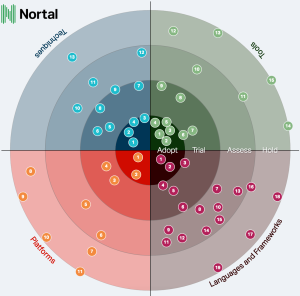Blog
by Priit Liivak
Building Nortal Technology Radar
Few months ago around twenty developers from Nortal gathered in a forest cabin to discuss our experiences and all things relevant in software development and as a result build Nortal Technology Radar. The result has already proved to be valuable but the process itself taught us a lot as well. I want to share the process, our experience and lessons learnt from building the radar.
What is Technology Radar?
I first came across Technology Radar concept several years back in ThoughtWorks blog. They have been publishing the radar for more than 5 years now. ThoughtWorks itself describes the radar in their FAQ as follows:
The radar is a document that sets out the changes that we think are currently interesting in software development – things in motion that we think you should pay attention to and consider using in your projects. It reflects the idiosyncratic opinion of a bunch of senior technologists based on our day-to-day work and experiences. While we think this is interesting, it should not be taken as a deep market analysis.
This document visualizes technologies or techniques on a radar graph. Each placement on a radar is called a blip. On a radar, these blips are divided into four quadrants: Tools, Languages and Frameworks, Platforms, Techniques.
More important than a specific quadrant is the placement of blip that represents a technology or technique within one of the four rings – placement describes an opinionated view towards given technology or technique. Starting from the inner circle there are 4 possible placements:
- Adopt – blips in this ring should be followed and used. We have experience and trust in these technologies. As ThoughtWorks has described it: “as close to a no brainer as possible”
- Trial – these items are mature enough to be battle-tested in the projects that reveal the true limitations and benefits of these technologies and techniques.
- Assess – technologies within this circle need research. We see a lot of potential in these technologies, but we are not certain if they provide long lasting meaningful impact on our business and our clients.
- Hold – in this circle you will find blips that we are skeptical of and believe should be addressed with caution. We believe there are better alternatives available or ideas behind these blips are not yet mature enough for serious consideration.
Why we built it?
For me ThoughtWorks Radar has always been mostly about discovering new technologies and techniques. Although the content they publish is interesting, very small part of it usually applies to Nortal. There is difference in technologies and programming languages we mostly use and the markets we operate are not similar either. All this led to an idea to build our own radar.
Building Nortal Technology Radar with the team meant a lot of debates and discussions. Once we introduced near final product to other colleagues at Nortal, we triggered some more discussions. The fact that nobody was indifferent was positive for us and showed the document compiled and the technologies included really were relevant for our developers.
The preparations
The first step was to clearly define the scope of this radar. We were building it as developers of Nortal Estonia. We were expressing our opinions about these technologies, keeping aside the projects we are currently working on. We also understood that in different geographies, where Nortal operates, this radar will look different and all content might not apply. Building the radar only for Estonia allowed us to test the concept on smaller scale and understand this single market better. Now I know that this is an exercise I’d like to do in other locations where Nortal operates as well. This would provide a great sample and an opportunity to compare different views, technologies and techniques.
Before we started working on the content for the radar, I processed available resources on the topic. There is a rather thorough description of the ThoughtWorks process by Neal Ford that was a lot of help. There is also an open source project developed by ThoughtWorks for actually putting the radar together. Unfortunately the techradar.io project did not work for me – it had a lot of dependencies and was written in Ruby that we don’t have experience with.
Continuing research led me to a simple JavaScript project built for the same purpose. I’m happy to say that now there is also a Nortal fork based on that project that I like even more. I’m biased though since I implemented most of the improvements myself.
A week before the event I asked all participants to prepare the list of technologies they feel are relevant today. The suitability for radar was not relevant at this stage – we were going to discuss that later. I also shared brief description of the radar and link to most recent ThoughtWorks technology radar. I understand now that I should have started planning even earlier to allow participants gather even more ideas.
The process
We met in a forest cabin, away from all distractions. After introducing the structure of the radar, everyone wrote on sticky notes the technologies they had thought of and prepared. These notes were divided into four categories representing the circles on our radar: adopt, trial, assess and hold. Couple of us grouped the notes with similar keywords within each of these categories.
Then it was time to discuss and debate. We picked out notes one by one and the person who wrote it described it briefly. This introduction provided very valuable context that helped us decide if and where to place it on the radar. As some of the proposed technologies were new to other members of the group, we also gained new knowledge and learned from each other a lot. In case of each proposed technology we tried to answer to three main questions:
- Should we include it as a blip in our radar?
- What quadrant does this blip belong to?
- Inside which circle should this blip be placed in?
Some topics sparked strong opinions and including a moderator was a great idea and helped to direct and keep the discussion on the right course. Most of the time we managed to reach an agreement nicely after some clarifying discussions, but in more complex cases we also used voting to make a final decision.
These conversations and debates lasted a full day and continued in sauna afterwards, but the work was far from done. We also wanted to add descriptions for each blip explaining why we think the way we do. If possible, we wanted descriptions to also contain references to projects or contacts within the company who had more information or experience on the specific matter.
Publishing the radar
We will be publishing a trimmed down version of the radar for everyone to browse in an upcoming post within September. As with ThoughtWorks technology radar, ours should not not be considered as deep market analysis. It’s not reflecting Nortal projects either, but rather our developers’ opinionated view on the technological landscape today. It includes technologies and techniques these specialists believe in or have experience with.
Stay tuned, the radar is soon to come. In the meanwhile, please feel free to share with us ideas about what would be on your radar: http://bit.ly/your_radar. All respondents will get an early access to Nortal Technology Radar.
Get in touch
Let us offer you a new perspective.



